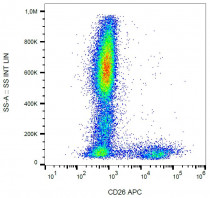ARG53802
anti-CD26 / DPP4 antibody [BA5b] (APC)
anti-CD26 / DPP4 antibody [BA5b] (APC) for Flow cytometry and Human
Cancer antibody; Cell Biology and Cellular Response antibody; Developmental Biology antibody; Immune System antibody; Metabolism antibody
Overview
| Product Description | APC-conjugated Mouse Monoclonal antibody [BA5b] recognizes CD26 / DPP4 |
|---|---|
| Tested Reactivity | Hu |
| Tested Application | FACS |
| Specificity | The clone BA5b recognizes CD26, a 110 kDa type II membrane glycoprotein, which is a peptidase expressed on mature thymocytes, T cells (especially activated), B cells, NK cells and macrophages. HLDA VI; WS Code N-L078 |
| Host | Mouse |
| Clonality | Monoclonal |
| Clone | BA5b |
| Isotype | IgG2a |
| Target Name | CD26 / DPP4 |
| Antigen Species | Human |
| Immunogen | A human T cell clone |
| Conjugation | APC |
| Alternate Names | T-cell activation antigen CD26; ADCP2; ADCP-2; DPP IV; Adenosine deaminase complexing protein 2; CD26; EC 3.4.14.5; ADABP; Dipeptidyl peptidase IV soluble form; Dipeptidyl peptidase IV; Dipeptidyl peptidase 4; Dipeptidyl peptidase IV membrane form; TP103; DPPIV; CD antigen CD26 |
Application Instructions
| Application Suggestion |
|
||||
|---|---|---|---|---|---|
| Application Note | * The dilutions indicate recommended starting dilutions and the optimal dilutions or concentrations should be determined by the scientist. |
Properties
| Form | Liquid |
|---|---|
| Purification Note | The purified antibody is conjugated with cross-linked Allophycocyanin (APC) under optimum conditions. The conjugate is purified by size-exclusion chromatography and adjusted for direct use. No reconstitution is necessary. |
| Buffer | PBS, 15 mM Sodium azide and 0.2% (w/v) high-grade protease free BSA |
| Preservative | 15 mM Sodium azide |
| Stabilizer | 0.2% (w/v) high-grade protease free BSA |
| Storage Instruction | Aliquot and store in the dark at 2-8°C. Keep protected from prolonged exposure to light. Avoid repeated freeze/thaw cycles. Suggest spin the vial prior to opening. The antibody solution should be gently mixed before use. |
| Note | For laboratory research only, not for drug, diagnostic or other use. |
Bioinformation
| Database Links | |
|---|---|
| Gene Symbol | DPP4 |
| Gene Full Name | dipeptidyl-peptidase 4 |
| Background | CD26, also known as dipeptidyl peptidase IV (DPP-IV), is a homodimeric cell surface serine peptidase that degradates IFN-gamma-induced cytokines, acts as a T cell costimulatory molecule, and participates in multiple immunopathological roles in leukocyte homing and inflammation. Alterations in its peptidase activity are characteristic of malignant transformation. The enzymatic activity increases dramatically with tumour grade and severity. CD26 is expressed in various blood cell types, but also e.g. in cells that are histogenetically related to activated fibroblasts. Alterations in CD26 density have been reported on circulating monocytes and CD4+ T cells during rheumatoid arthritis and systemic lupus erythematosus. |
| Function | Cell surface glycoprotein receptor involved in the costimulatory signal essential for T-cell receptor (TCR)-mediated T-cell activation. Acts as a positive regulator of T-cell coactivation, by binding at least ADA, CAV1, IGF2R, and PTPRC. Its binding to CAV1 and CARD11 induces T-cell proliferation and NF-kappa-B activation in a T-cell receptor/CD3-dependent manner. Its interaction with ADA also regulates lymphocyte-epithelial cell adhesion. In association with FAP is involved in the pericellular proteolysis of the extracellular matrix (ECM), the migration and invasion of endothelial cells into the ECM. May be involved in the promotion of lymphatic endothelial cells adhesion, migration and tube formation. When overexpressed, enhanced cell proliferation, a process inhibited by GPC3. Acts also as a serine exopeptidase with a dipeptidyl peptidase activity that regulates various physiological processes by cleaving peptides in the circulation, including many chemokines, mitogenic growth factors, neuropeptides and peptide hormones. Removes N-terminal dipeptides sequentially from polypeptides having unsubstituted N-termini provided that the penultimate residue is proline. [UniProt] |
| Research Area | Cancer antibody; Cell Biology and Cellular Response antibody; Developmental Biology antibody; Immune System antibody; Metabolism antibody |
| Calculated MW | 88 kDa |
| PTM | The soluble form (Dipeptidyl peptidase 4 soluble form also named SDPP) derives from the membrane form (Dipeptidyl peptidase 4 membrane form also named MDPP) by proteolytic processing. N- and O-Glycosylated. Phosphorylated. Mannose 6-phosphate residues in the carbohydrate moiety are necessary for interaction with IGF2R in activated T-cells. Mannose 6-phosphorylation is induced during T-cell activation. |
Images (1) Click the Picture to Zoom In






